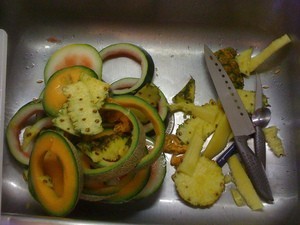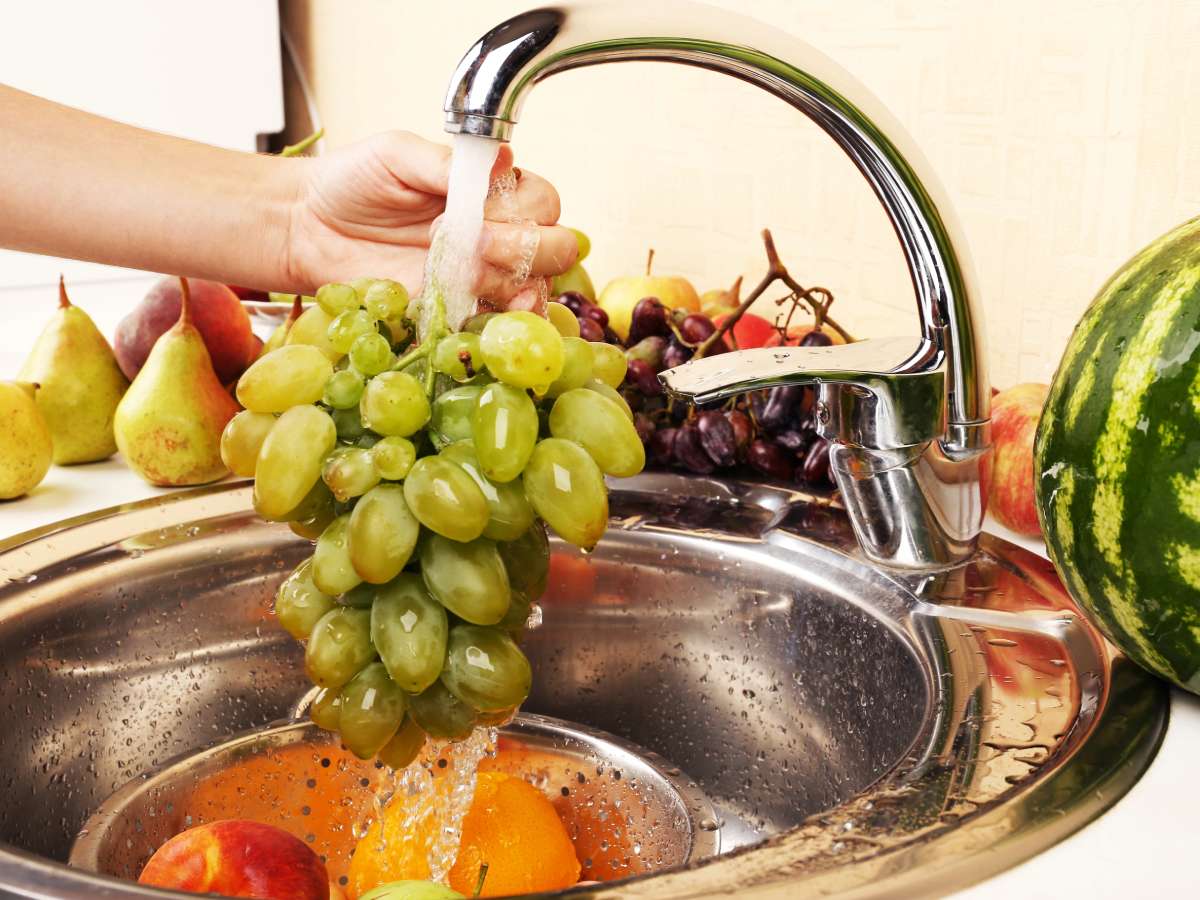 Would you believe not everyone has a garbage disposal in their kitchen sink? In fact, only half of U.S. households have a garbage disposal.
Would you believe not everyone has a garbage disposal in their kitchen sink? In fact, only half of U.S. households have a garbage disposal.
I never had a garbage disposal until I moved into my apartment in Portland. I’d never even used one before!
Unfortunately, I just assumed that I could put any food into the garbage disposal and all would be fine.
Wrong!
I soon discovered that there are some foods that you simply cannot put down into the garbage disposal. And there are certain ways to use a garbage disposer that make it work more efficiently.
Here’s a list of food scraps that cannot be put down the garbage disposal, plus tips for getting the most of that handy disposer in your kitchen sink…
3 Things To Know About Garbage Disposals
One night when I was grinding up vegetable peels, the garbage disposal just stopped working.
Boy, was I steamed.
After doing some research, I discovered that you can’t just throw whatever you want into the garbage disposal.
The 3 things I learned:
#1 You have to be careful about what you put in the garbage disposal in the first place (details below).
If it is not gonna leak through a paper bag [when tossed in your regular garbage], it doesn’t need to go in the garbage disposal. — Franken
#2 You should always run large amounts of cold water whenever the garbage disposal is running, and start the water running before the first food scrap hits the drain.
Cold water solidifies grease, which causes it to float down your pipes rather harmlessly. If you use hot water, grease will melt in the disposal, and then when it reaches a cooler part of you waste plumbing, it will grab hold of the side and hang on. Also cold water causes many things to harden, which although it sounds like nonsense, helps the disposal; since the disposal would rather break things than cut then, harder things are better because they are more brittle and break rather than flexing and bouncing around down there. — Rent A Husband
#3 You should only send small amounts of food scraps into the garbage disposal at a time.
Insert garbage loosely. If you pack in too much at once, you can jam the disposal. — Friendly Plumber
Here’s the proper way to use a garbage disposal and care for it over time.
As it turned out, it wasn’t what I was grinding up in the garbage disposal (vegetable peels), but how much of it at a time I was sending into the disposal.
Foods That Should Never Be Put Into A Garbage Disposal
So that the same thing that happened to me doesn’t happen to you, following are some tips for getting the most from your garbage disposal, plus foods that you should never put into a garbage disposal.
![]() Grease & Oil. Yes, even though it’s food-grade oil for use in cooking, it’s not easily digestible by your garbage disposal. Grease tends to congeal and slime up the inside of the garbage disposal, hampering its overall effectiveness. Not to mention the fact that grease can wreak havoc on your pipes! As a precaution, any time you’re sending food scraps down the drain that have a greasy residue (from butters and oils), always run a boatload of cold water at the same time (as mentioned above).
Grease & Oil. Yes, even though it’s food-grade oil for use in cooking, it’s not easily digestible by your garbage disposal. Grease tends to congeal and slime up the inside of the garbage disposal, hampering its overall effectiveness. Not to mention the fact that grease can wreak havoc on your pipes! As a precaution, any time you’re sending food scraps down the drain that have a greasy residue (from butters and oils), always run a boatload of cold water at the same time (as mentioned above).
![]() Meat (especially greasy meat, raw meat, or meat with gristle). Raw meat becomes stringy and wraps around the blades. Gristle can dull the blades in your garbage disposal be very difficult to grind up. And we all know the downsides of disposing grease at this point. It’s better to bag up whatever meat you need to dispose of and take it out to the trash — rather than put meat down the garbage disposal. If you must send meat into the garbage disposal, make sure to only send very small pieces.
Meat (especially greasy meat, raw meat, or meat with gristle). Raw meat becomes stringy and wraps around the blades. Gristle can dull the blades in your garbage disposal be very difficult to grind up. And we all know the downsides of disposing grease at this point. It’s better to bag up whatever meat you need to dispose of and take it out to the trash — rather than put meat down the garbage disposal. If you must send meat into the garbage disposal, make sure to only send very small pieces.
![]() Pasta & Rice (cooked or not). The starch in rice and noodles (and quinoa) causes them to be slimy and wrap around the blades of a garbage disposal, which could cause it to stop working. In addition, regardless of how much water you run or how long you run the garbage disposal, you can never break down rice or pasta small enough because rice and pasta swell when they come in contact with water. That means the small pieces will enlarge and accumulate in the trap of your pipes until it becomes clogged.
Pasta & Rice (cooked or not). The starch in rice and noodles (and quinoa) causes them to be slimy and wrap around the blades of a garbage disposal, which could cause it to stop working. In addition, regardless of how much water you run or how long you run the garbage disposal, you can never break down rice or pasta small enough because rice and pasta swell when they come in contact with water. That means the small pieces will enlarge and accumulate in the trap of your pipes until it becomes clogged.
![]() Potatoes & Potato Skins. Again, it’s the starch in potatoes and potato skins that ultimately becomes a gummy glue which wraps around the garbage disposal’s moving parts and clogs up pipes. Instead, peel potatoes into a strainer or into the sink with something covering the garbage disposal.
Potatoes & Potato Skins. Again, it’s the starch in potatoes and potato skins that ultimately becomes a gummy glue which wraps around the garbage disposal’s moving parts and clogs up pipes. Instead, peel potatoes into a strainer or into the sink with something covering the garbage disposal.
The worst things, bar none, to put in a garbage disposal? Potato peels. And cooked rice. Both, but especially potato peels turn into glue in your drain, as the starch gets ground up, sitting in your pipes to harden or just cause a blockage if not enough water pushes it all the way to the water treatment plant. A little bit, a little at a time may be fine, but that Thanksgiving dinner or Xmas dinner potato preparation could cause you a large plumber’s bill. Beware!!! — Handyman
![]() Flour. Similar to potatoes, flour becomes glue-like when wet. It then thickens and hardens when dry. This can wreak havoc on your garbage disposal.
Flour. Similar to potatoes, flour becomes glue-like when wet. It then thickens and hardens when dry. This can wreak havoc on your garbage disposal.
![]() Stringy, Fibrous Foods (corn husks, celery, lettuce, asparagus, onion peels, and garlic ends). Any foods with stringy parts or papery-thin skins should be avoided. They tend to wrap around the blades and moving parts of the garbage disposal and can even get tangled around the blade motor.
Stringy, Fibrous Foods (corn husks, celery, lettuce, asparagus, onion peels, and garlic ends). Any foods with stringy parts or papery-thin skins should be avoided. They tend to wrap around the blades and moving parts of the garbage disposal and can even get tangled around the blade motor.
![]() Fruit Peels & Rind. The thick tough skin is what does not break down easily in a garbage disposal. In small pieces, these may be okay, but never half a fruit or larger at one time. Since banana peels are very tough and very long (not to mention slimy and slightly stringy), it’s not advised that you toss them into the garbage disposal. They could cause your disposer to seize up and quit working.
Fruit Peels & Rind. The thick tough skin is what does not break down easily in a garbage disposal. In small pieces, these may be okay, but never half a fruit or larger at one time. Since banana peels are very tough and very long (not to mention slimy and slightly stringy), it’s not advised that you toss them into the garbage disposal. They could cause your disposer to seize up and quit working.
![]() Eggshells. These are a hot topic that brings much discussion among homeowners. Some have had good luck putting egg shells down the disposal, others have shared personal horror stories after sending eggshells into the garbage disposal. Here are 2 such stories:
Eggshells. These are a hot topic that brings much discussion among homeowners. Some have had good luck putting egg shells down the disposal, others have shared personal horror stories after sending eggshells into the garbage disposal. Here are 2 such stories:
Egg shells may not damage the disposal, but they may very well contribute to clogging pipes. I had a major clog under my house recently and the plumber saw eggshells (along with other stuff) come out with the roto-rooter. He said “never never put eggshells down the disposal”.
If you put too many egg shells down the disposal because they get ground up so finely they get caught in the trap underneath the sink (this has happened to me twice) and the next time you use the dishwasher the water pressure, if you are lucky, causes the water to get backed up. If you are unlucky, like myself, it causes the pressure to build up in the pipes until the force apart and spew water under the sink during the night and you are left with a soggy mess. One or 2 egg shells with a lot of water is okay but 3 or more seems to be a bad idea!!!
![]() Non-Food Items. These items do not fare well in garbage disposals: glass, metal, paper, plastic, string, rubber bands, rocks, cigarette butts, and bones. They can completely break down your garbage disposal, making it unusable.
Non-Food Items. These items do not fare well in garbage disposals: glass, metal, paper, plastic, string, rubber bands, rocks, cigarette butts, and bones. They can completely break down your garbage disposal, making it unusable.
The most popular size of garbage disposal is a 3/4 HP motor with enough power to handle even the stringiest of vegetables. Compact models usually have 1/4 to 1/2 HP motors and the largest disposers have powerful 1 HP units. Actual capacities of disposers tend to vary and compact models most often are quite adequate for families. Source
In the end, it’s best not to think of your garbage disposal as a substitute for a kitchen garbage can. The best advice is to scrape all food scraps from plates, pots, and pans directly into the garbage can and only use the garbage disposal for the smaller food particles that remain.
A garbage disposal is a long-lasting durable piece of equipment that serves a kitchen well. If you keep the above tips in mind, and don’t do to your garbage disposal what I did to mine, then you will get many years of life from this handy kitchen gadget. However, if you’re careless about what you send down the disposal and how you use it, you’ll probably be looking for a garbage disposal repair manual soon!
More About Garbage Disposals & Food Scraps
- Anatomy Of A Garbage Disposal
- How To Use & Maintain A Garbage Disposal
- Garbage Disposal Do’s & Don’ts
- Tips To Prolong The Life Of Your Garbage Disposal
- How Garbage Disposals Work
- Pros & Cons Of Putting Coffee Grounds In The Disposer
- Troubleshooting 6 Garbage Disposal Problems
For the record, the “blades” in your disposal are not blades. You might think of them as hammers. There are no sharp edges on then. Think of them as 2 or so hammers banging against the food at incredible speed, shattering it into tiny pieces … Hence, the firmer the debris in the disposal, the easier it is to break it apart. That is why stringy things don’t get chopped up. They kinda ooze thru the holes, clogging things up. — Handyman



